
Transport in Norway is highly influenced by Norway's low population density, narrow shape and long coastline. Norway has old water transport traditions, but road, rail and air transport have increased in importance during the 20th century. Due to the low population density, public transport is somewhat less built out in rural areas of Norway, however public transport in, and around cities is well developed.

A smart card, chip card, or integrated circuit card is a physical electronic authentication device, used to control access to a resource. It is typically a plastic credit card-sized card with an embedded integrated circuit (IC) chip. Many smart cards include a pattern of metal contacts to electrically connect to the internal chip. Others are contactless, and some are both. Smart cards can provide personal identification, authentication, data storage, and application processing. Applications include identification, financial, mobile phones (SIM), public transit, computer security, schools, and healthcare. Smart cards may provide strong security authentication for single sign-on (SSO) within organizations. Numerous nations have deployed smart cards throughout their populations.

The Oslo Metro is the rapid transit system of Oslo, Norway, operated by Sporveien T-banen on contract from the transit authority Ruter. The network consists of five lines that all run through the city centre, with a total length of 85 kilometres (53 mi), serving 101 stations of which 17 are underground or indoors. In addition to serving 14 out of the 15 boroughs of Oslo, two lines run to Kolsås and Østerås, in the neighboring municipality of Bærum. In 2016, the system had an annual ridership of 118 million.
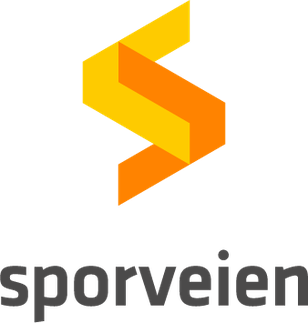
Sporveien Oslo AS is a municipally owned public transport operator in Oslo, Norway. It operates the trackage and maintains the stock of the Oslo Metro and Oslo Tramway, as well as owning eight operating subsidiaries. In 2005, its 2,365 employees transported 160 million passengers 710 million kilometers, and since 2008 it has operated on contract with the public transport authority Ruter.

Stortinget is an underground rapid transit station on the Common Line of the Oslo Metro, Norway. It is located in the heart of the city center, next to the Parliament of Norway Building (Stortinget). The station is served by all of the five lines of the metro. At the street level, the station serves tram routes 11, 12, 13, 17, 18 and 19. Lines 11, 12 and 13 serves Øvre Slottsgate on the Vika Line while Lines 17, 18 and 19 stops at Tinghuset in the Ullevål Hageby Line. Also close to the station, there is a stop named Prof. Aschehougs gate that stops line FB5 to Oslo Airport, Gardermoen. Stortinget is 'kilometer marker zero' for the metro network and is owned by Sporveien T-banen.
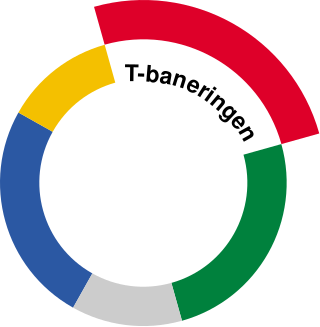
The Ring Line is the newest rapid transit loop line of the Oslo Metro of Oslo, Norway. It connects to the Sognsvann Line in the west and the Grorud Line in the east; along with these two lines and the Common Tunnel, the Ring Line creates a loop serving both the city centre and Nordre Aker borough. The 5.0 kilometres (3.1 mi)-long line has three stations: Nydalen, Storo and Sinsen. Four-fifths of the line runs within two tunnels, with the 1.0-kilometer (0.62 mi) section between Storo and Sinsen, including both stations, being the only at-grade part. The line connects to the Grorud Line north of Carl Berners plass and with the Sognsvann Line north of Ullevål stadion.
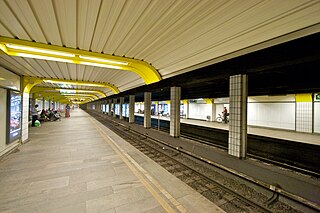
The Common Tunnel, sometimes called the Common Line, is a 7.3-kilometer (4.5 mi) long tunnel of the Oslo Metro which runs through the city center of Oslo, Norway. The name derives from the fact that all five lines of the metro use the tunnel, which runs from Majorstuen to Tøyen. The section has six stations, including the four busiest on the metro.

AS Oslo Sporveier or the Oslo Public Transport Administration is a municipally owned limited company that is responsible for planning, marketing and organising the public transport in Oslo, Norway. The company does not operate any public transport, but instead either awards public service obligation (PSO) contracts or negotiates contracts with Oslo T-banedrift and Oslo Sporvognsdrift concerning the operation of Oslo T-bane and the Oslo Tramway.
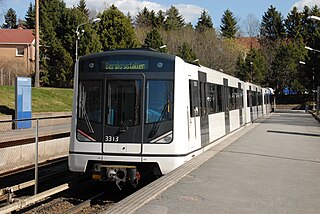
MX3000 is an electric train used on Oslo Metro in Oslo, Norway. The multiple units are produced by Siemens Mobility, who started serial delivery in 2007. Seventy-eight three-car units were ordered by Sporveien, and five by Akershus County Municipality. They replaced the older T1000 and T1300 stock that was used on the Oslo Metro since 1966. By 2010, the last T1000 and T1300 trains had been retired and replaced by 83 three-car units. 32 additional sets were ordered, and the final train set was delivered in 2014, increasing the fleet to 115 units.

Sandvika Station is a railway station located at Sandvika in Bærum, Norway. Situated on the Drammen Line, 14.14 kilometers (8.79 mi) from Oslo S, it also an intermediate station of the Asker Line. Vy serves the station with local and regional, with about 7,000 passengers using the station daily. It is also served by the Airport Express Train and serves as the main bus terminal for the town. The station is elevated and has two island platforms and four tracks.

The OV-chipkaart is a contactless smart card system used for all public transport in the Netherlands. First introduced in the Rotterdam Metro in April 2005, it has subsequently been rolled out to other areas and travel modes. It fully replaced the national strippenkaart system for buses, trams, and metro trains in 2011, and the paper ticket system for rail travel in July 2014.

Ruter AS is the public transport authority for Oslo and Akershus counties in Norway. Formally a limited company – 60% of its shares are owned by the Oslo county municipality and 40% by that of Akershus – it is responsible for the administration, funding, and marketing of public transport in the two counties, including buses, the Oslo Metro, Oslo Trams, and ferry services. Ruter also holds agreements with Entur concerning the regulation of fares on local and regional train services operated within the two counties.

A transit pass or travel card, often referred to as a bus pass or train pass etc., is a ticket that allows a passenger of the service to take either a certain number of pre-purchased trips or unlimited trips within a fixed period of time.
Strømmens Værksted A/S was an industrial company based in Skedsmo, Norway, specialising in the production of rolling stock. Founded in 1873, it remains as a part of Bombardier Transportation. The plant is located just off Hovedbanen west of Strømmen Station.

Oslo Commuter Rail is a commuter rail centered in Oslo, Norway, connecting the capital to six counties in Eastern Norway. The system is operated by Vy and its subsidiary Vy Gjøvikbanen, using Class 69 and Class 72 electric multiple units (EMU). The network spans eight routes and 128 stations, with Oslo Central Station (Oslo S) as the central hub. The trains run on 553 kilometers (344 mi) of electrified mainline railway owned by the Bane NOR. Deficits are financed by the Norwegian Ministry of Transport, although the network also has a ticketing cooperation with Ruter, the public transport authority in Oslo and Akershus. The network is the longest commuter rail network in the Nordic countries, and among top ten in Europe.

Nationaltheatret is an underground metro station and tram stop serving Vika and the city center of Oslo, Norway. It is located on the Common Tunnel of the Oslo Metro and on the Briskeby Line of the Oslo Tramway. Also located at the same place is Nationaltheatret Station of the Drammen Line. The station is served by all five lines of the metro, and lines 11 and 13 of the tramway. In addition, several bus services call at the station. It is named for the National Theatre located nearby.

The rolling stock of Oslo Metro, Norway, has consisted of three classes: T1000/T1300, T2000 and MX3000. The T1000 was built as 162 single cars from 1964 to 1978. From 1979 to 1985, 33 new T1300 trains were built, followed by the conversion of 16 T1000s. Six two-car T2000 units were delivered in 1994. Since 2005, the first 83 three-car MX3000 units have been replacing the older stock, and the last T1000 was retired in 2007. From 2010, only MX3000-trains are in use. The T1000/T1300 and T2000 were built by Strømmens Værksted, with motors from Norsk Elektrisk & Brown Boveri (NEBB) and AEG, respectively, and the MX3000 were built by Siemens.

The AT HOP card is an electronic fare payment card that was released in two versions on Auckland public transport services, beginning in May 2011. The smart card roll out was the first phase in the introduction of an integrated ticketing and fares system that was rolled out across the region.
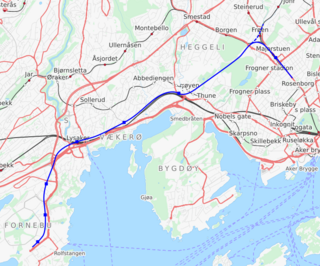
The Fornebu Line is an under construction rail line which will serve the peninsula of Fornebu in Bærum, Norway. The line is under construction and the transit agency Ruter is working towards connecting it to the Oslo Metro. The line has at various stages been proposed as an automated people mover, tram-train, tramway, light rail, stadtbahn, rapid transit, bus rapid transit and commuter rail, with the rapid transit option being selected as the final proposal. The metro line will start at Majorstuen Station and will run entirely in a tunnel for 8,150 meters (26,740 ft). The line will have six stations, at Skøyen, Vækerø, Lysaker, Telenor Arena, Flytårnet and Fornebu Senter. A depot will be built at Fornebu and the line will connect to the metro's Common Tunnel at Majorstuen.



















